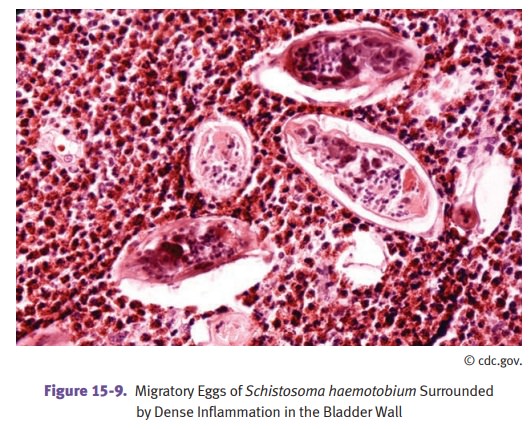Chapter: Pathology: Renal Pathology
Urinary Bladder Pathology
URINARY BLADDER PATHOLOGY
Congenital
anomalies of the bladder. Exstrophy of the bladder is a developmental failure of the formation of
the abdominal wall and bladder which leaves the blad-der open at the body
surface. Urachal cyst remnants may permit drainage of urine from a newborn’s
umbilicus, and may also be a cause of bladder adenocarcinoma.
Cystitis. The etiology of cystitis varies, with important
causes including organ-isms, notably from fecal flora (Escherichia coli, Proteus, Klebsiella, Enterobacter); radiation
cystitis (may follow radiation therapy); and chemotherapy agents such as
cyclophosphamide (hemorrhagic cystitis).
Clinically, it affects
females far more than males. Symptoms include frequency, urgency, dysuria, and
suprapubic pain; systemic signs such as fever and malaise are uncommon.
Predisposing factors include benign prostatic hypertrophy, bladder calculi, and
cystocele.
Malakoplakia is a bladder inflammatory pattern associated
with a defect in macro-phage function. The cause is unknown. Macrophages
contain Michaelis-Gutmann bodies, laminated basophilic
structures.
Urinary bladder tumors are most commonly due to
transitional cell carcinoma. There is an increasing
incidence of urinary bladder tumors; males are affected more than females, and
peak incidence is age 40-60. Risk factors include:
•
Cigarette smoking and occupational exposure to azo dye production
(transi-tional cell carcinoma) (both due to 2-naphthylamine)
•
Chronic bladder infection with Schistosoma
haemotobium (squamous cell car-cinoma) (Africa including Egypt and the
Middle East)
Bladder cancer usually
presents with painless hematuria, but it may also cause dys-uria, urgency,
frequency, hydronephrosis, and pyelonephritis.
Prognosis of bladder cancer
depends on the tumor grade and stage. There is a high incidence of recurrence.
Precursors of invasive transitional cell carcinoma can arise from a flat or
papil-lary lesion.
•
Carcinoma
in situ (CIS) is a high-grade lesion with cytologic atypia in the full thickness of the epithelium. It is frequently
multifocal. In 50-75% of untreated cases, it progresses to invasive cancer.
•
Papillary precursors to invasive carcinoma include papilloma ⇒ papillary
urothelial neoplasia of low malignant
potential ⇒
low-grade urothelial carcinoma ⇒ high-grade urothelial carcinoma.
Other bladder tumors include
papillomas, adenocarcinoma, and embryonal rhab-domyosarcoma.

Miscellaneous bladder conditions
•
Acquired
diverticuli can complicate urinary tract outlet obstruction due to benign prostatic hyperplasia or other causes.
•
Cystocele
is the
term used for prolapse of the bladder into the vagina. It is common in middle-aged to elderly women.
•
Cystitis
cystica et glandularis causes formation of small cysts and glands in the bladder mucosa related to chronic
inflammation. It is associated with an increased risk of adenocarcinoma.
Related Topics